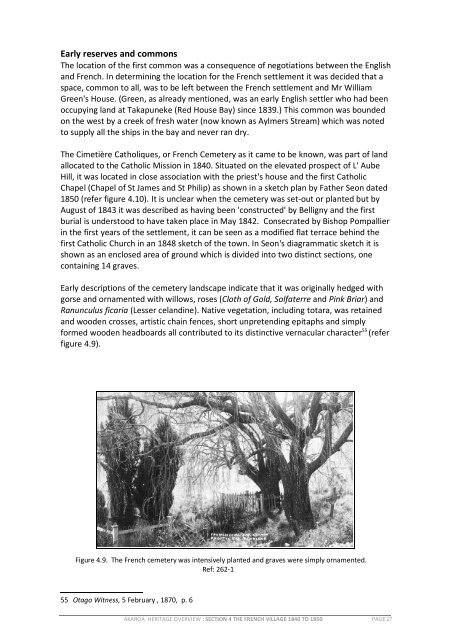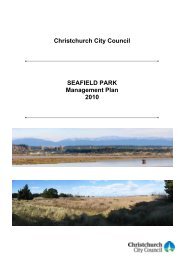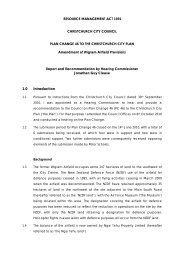Akaroa Historical Overview - Christchurch City Council
Akaroa Historical Overview - Christchurch City Council
Akaroa Historical Overview - Christchurch City Council
You also want an ePaper? Increase the reach of your titles
YUMPU automatically turns print PDFs into web optimized ePapers that Google loves.
Early reserves and commons<br />
The location of the first common was a consequence of negotiations between the English<br />
and French. In determining the location for the French settlement it was decided that a<br />
space, common to all, was to be left between the French settlement and Mr William<br />
Green's House. (Green, as already mentioned, was an early English settler who had been<br />
occupying land at Takapuneke (Red House Bay) since 1839.) This common was bounded<br />
on the west by a creek of fresh water (now known as Aylmers Stream) which was noted<br />
to supply all the ships in the bay and never ran dry.<br />
The Cimetière Catholiques, or French Cemetery as it came to be known, was part of land<br />
allocated to the Catholic Mission in 1840. Situated on the elevated prospect of L' Aube<br />
Hill, it was located in close association with the priest's house and the first Catholic<br />
Chapel (Chapel of St James and St Philip) as shown in a sketch plan by Father Seon dated<br />
1850 (refer figure 4.10). It is unclear when the cemetery was set-out or planted but by<br />
August of 1843 it was described as having been 'constructed' by Belligny and the first<br />
burial is understood to have taken place in May 1842. Consecrated by Bishop Pompallier<br />
in the first years of the settlement, it can be seen as a modified flat terrace behind the<br />
first Catholic Church in an 1848 sketch of the town. In Seon's diagrammatic sketch it is<br />
shown as an enclosed area of ground which is divided into two distinct sections, one<br />
containing 14 graves.<br />
Early descriptions of the cemetery landscape indicate that it was originally hedged with<br />
gorse and ornamented with willows, roses (Cloth of Gold, Solfaterre and Pink Briar) and<br />
Ranunculus ficaria (Lesser celandine). Native vegetation, including totara, was retained<br />
and wooden crosses, artistic chain fences, short unpretending epitaphs and simply<br />
formed wooden headboards all contributed to its distinctive vernacular character 55 (refer<br />
figure 4.9).<br />
Figure 4.9. The French cemetery was intensively planted and graves were simply ornamented.<br />
Ref: 262-1<br />
55 Otago Witness, 5 February , 1870, p. 6<br />
AKAROA HERITAGE OVERVIEW : SECTION 4 THE FRENCH VILLAGE 1840 TO 1850 PAGE 27
















